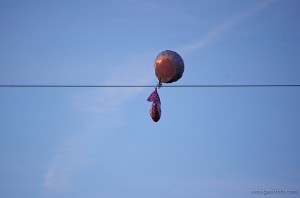
More than 4,700 PG&E customers in San Francisco lost power Wednesday afternoon when a bunch of Mylar balloons hit a power line. KQED happened to be one of those customers (it's OK; essential TV and radio operations have back-up generators), so we began to selfishly wonder: How, exactly, do balloons cause power outages?
It turns out there are two ways. The first is if the balloon makes contact with two power lines. Since they're coated with a thin layer of metal, they conduct electricity between the lines and create a short.
"It's kind of like letting the lightning out of those wires," explains Joe Molica, a spokesman for PG&E. (I don't watch "Breaking Bad," but apparently this is a notable—spoiler and profanity alert—example.)
The other way is if the balloon's metal streamers come in contact with something else, creating a ground that the electricity travels down.
Either way the power lines can be damaged, circuit breakers trip and the power goes out. So there are two elements to restoring power: resetting the breakers and repairing any damage. On Wednesday two lines came down. PG&E got most customers' power back within about half an hour, but 75 were in the dark for about five hours.